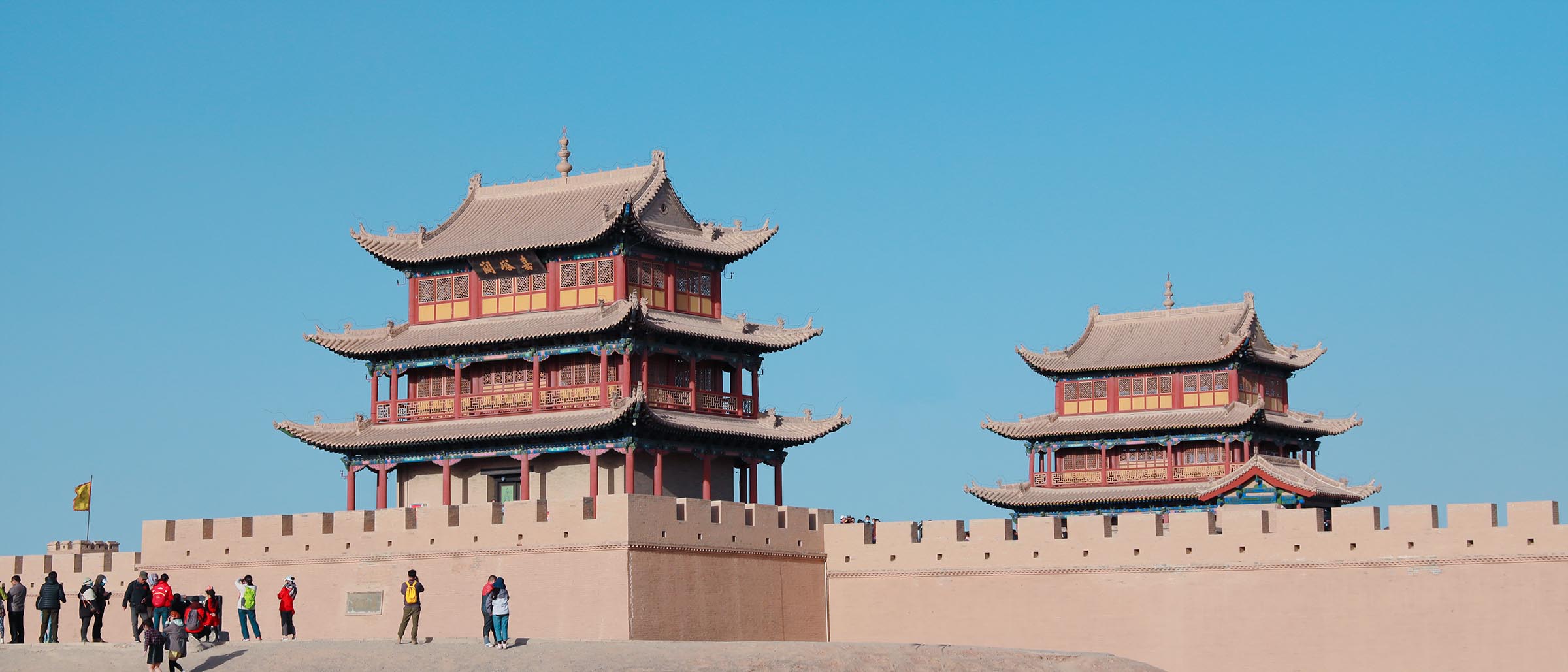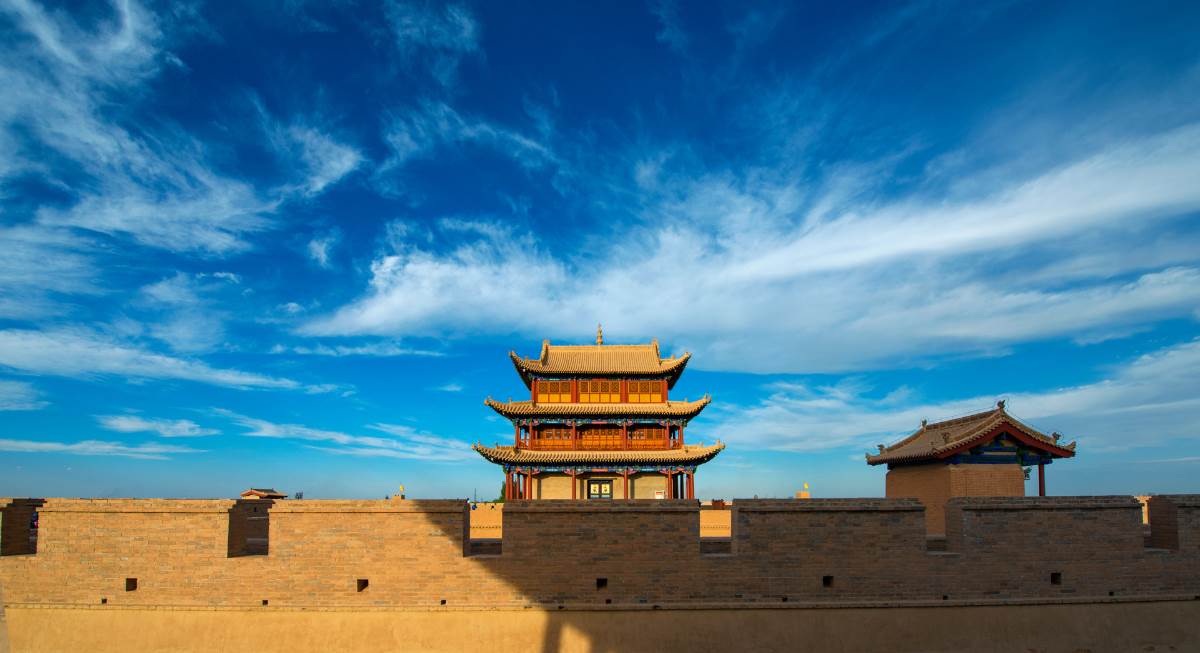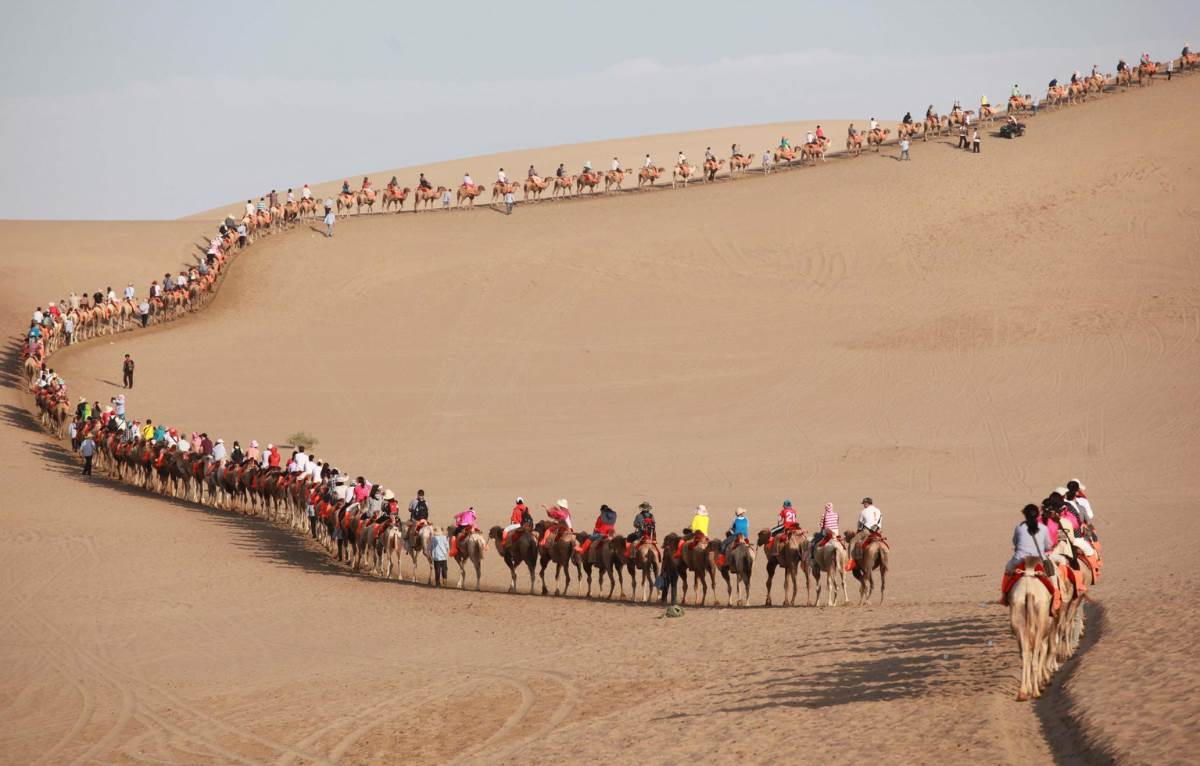- Gansu -
Synonymous with the Silk Road, the slender province of Gansu flows east to west along the Hexi Corridor, the gap through which goods and ideas once streamed between China and Central Asia. The constant flow of commerce left Buddhist statues, beacon towers, forts, chunks of the Great Wall and ancient trading towns in its wake. Gansu offers an entrancingly rich cultural and geographic diversity. Historians immerse themselves in Silk Road lore, art aficionados swoon before the wealth of Buddhist paintings and sculptures, while adventurers hike through desert rockland, ascend sand dunes and tread along high-mountain paths well worn by Tibetan nomads. The ethnic diversity is equally astonishing: throughout the province, the local Hui Muslims act as though the Silk Road lives on; in Xiahe and Langmusi a pronounced Tibetan disposition holds sway, while other minority groups such as the Baoan and Dongxiang join in the colourful minority patchwork.

Basic Information
Chinese Name: 甘肃 (Gan Su)
Location: Gansu lies between the Tibetan and Loess plateaus and borders Mongolia (Govi-Altai Province), Inner Mongolia and Ningxia to the north, Xinjiang and Qinghai to the west, Sichuan to the south and Shaanxi to the east.
Provicial Capital: Lanzhou
Area: The seventh-largest administrative district by area at 453,700 square kilometres (175,200 sq mi).
Population: Gansu has a population of 26 million, ranking 22nd in China.
Major Ethnic Groups: Han, Dongxiang, Yugu, Baoan, Hui, Tibet, etc.
Famous cities: Lanzhou, Dunhuang, Zhangye, Jiuquan
Gansu History
Gansu is one of the birthplaces of the Chinese nation and ancient Chinese civilization. In history, the world famous Silk Road traverses the whole province, thus made the province the earliest place opening to the outside world for economic and cultural exchanges between the east and the west as well as exchanges between different nationalities. As early as in the Old Stone Age of 200,000 years ago, the remote mankind had already lived and multiplied on this land. Fuxi and Shengnong, the earliest ancestors of the Chinese nation lived in compact communities in Tianshui. The ancestors of Zhou and Qin , both taking the eastern part of Gansu as their base, grew from strength to strength and fulfilled the great cause of unifying China. In the period of over 2,000 years from Han, Jin, Sui and Tang dynasties to Song, Yuan, Ming and Qing dynasties, Gansu had added a glorious chapter to the Chinese history and made great contribution to the economic and cultural exchanges between China and the western countries.
In the Sui and Tang dynasties, especially in the years of Kaiyuan and Tianbao Periods, the height of power and splendor of Tang Dynasty, Gansu became one of the economically prosperous areas. It’s agriculture, textile, gold production, water resources development and utilization took an important position in the whole country. According to the record of “the Comprehensive Mirror for Aid in Government”, “No place under heaven was as prosperous as Long”.
In Sui and Tang dynasties, trade between China and the western countries mainly through the land routes, which started from the ancient capital Chang’an, passed through Dunhuang, the western end of Hexi Corridor and then divided into different ways. After Sui Dynasty unified China and because of the powerful and prosperous national strength and continuous social and economic development in Gansu, people from the Western Regions came to Zhangye to do business with China. In the 3rd year of Daye Period, Emperor Suiyangdi paid an inspection tour to the Western Region and was warmly received by people from 27 tribes there with incense burling, and soldiers riding on horses with rich dresses. The welcoming people stretched dozens of miles.
Up to Tang dynasty, Gansu’s position in international trade reached an unprecedented height. Hexi became an important place for China’s external trade and large numbers of merchants came to Hexi for business. Thanks to the stable political environment and development of foreign trade, economy and social life in Hexi was very prosperous in the earlier and middle periods of Tang Dynasty. Poet Yuanzhen of Tang Dynasty once wrote such a poem: In the west Liangzhou the signs of human inhabitation and mulberry trees can be seen everywhere. People enjoy grape wine with music as they like. Brilliant red and blue flags are flying on the pavilions. This is the vivid description of the prosperity during that time.
Gansu Geography
Gansu has an area of 454,000 square kilometres, and the vast majority of its land is more than 1,000 metres above sea level. It lies between the Tibetan Plateau and the Loess Plateau, bordering Mongolia to the northwest, Inner Mongolia and Ningxia to the north, Shaanxi to the east, Sichuan to the south, and Xinjiang to the west.
Topography and Landforms The landforms in Gansu are complicated and varied. High mountains and deep valleys aloft on its southeastern part with peaks rising one higher than another. Covered by loess, a loess topography has formed in its eastern part. Hexi Corridor, the western fringe of the province has smooth terrain, oasis, dessert and Gobi desert. With cold climate and modern glacier, the terrain is highly situated in the southwestern part of the province.
The highest peak of the province is Tuanjie Peak of Qilian Mountain with an altitude of 5,808 meters above sea level and its lowest point is the bottom of Bailongjiang River valley in the eastern part of Wenxian county with an altitude of only 550 meters above sea level. The terrain in the whole province is descending to three levels as a flight of stairs. Hilly areas and plateau consist of 70% of the total land area while desert and Gobi desert consist of 14.99%. According to its topographic feature and structural formation, Gansu can be divided into 8 landform areas of Longnan hilly area, Longzhong loess plateau, Gannan plateau, Qilian mountainous area, Hexi corridor high land plain, Beishan mountainous area and Alashan plateau.
Gansu Climate
The Gansu province has a sundry landscape. It is a congregation the three plateaus namely the Loess Plateau, the Qinghai-Tibet Plateau and the Inner Mongolian Plateau and is surrounded by Shaanxi in the east, Sichuan in the south, Qinghai and Xinjiang in the west, Ningxia and Inner Mongolia in the north. The Hexi Corridor that covers the area of the ancient Silk Road is located on the northwestern part of Gansu and the Gobi desert is spread sporadically over Gansu.
Due to the complex geography and the greatly different elevation, the weather differs in different parts of Gansu. The climate of Gansu is temperate monsoonal but it has the typical characteristics of the continental climate. Gansu undergoes sharp temperature fluctuations in summer (June to August) and winter (December to February), with uneven and unpredictable precipitation throughout the year. In the west the average January temperature is -8 °C in Jiuquan, for instance, and -7 °C in Dunhuang, 320 km west of Jiuquan. The temperature in July in Jiuquan is 21 °C, and in Dunhuang it is 27 °C. Annual temperature variations for most parts of Gansu are more than 30 °C; the range in the average number of frost-free.
The average annual temperature of Gansu is 7-9 °C. The hottest month of July receives an average temperature of 20°C-24 °C and January being the coldest month receives an average temperature of -12 °C -2 °C approximately. The average annual rainfall is marked as 50-800 mm approximately. The rainy days mainly center in months from June to September. Dunhuang has the most sunlight, so the melons and fruits produced in Dunhuang are particularly sweet.
Gansu Cuisine
Along with the cultural exchanges on the ancient Silk Road, a unique culinary culture began to emerge. With the passage of time, the culinary cultures of different ethnic groups in Gansu took shape after absorbing the quintessence of the culinary culture of Central China, each with its own characteristics.
Dishes prepared by the Gansu people using locally produced materials exhibit strong characteristics of Northwest China.
Thanks to the influence of the Hui ethnic minority, dishes in Gansu revolve around roasting, steaming, and braising beef or mutton, with very little consumption of pork or chicken. Since the Hui people are Muslim, they are prohibited from eating pork, and the cold weather in northern China has given the locals a fondness for hearty red meat over white meat. A range of seasonings are also employed in Gansu cuisine, with a preference for salty and spicy flavours. Gansu-style dishes tend to be very fatty, oily, and rich, so be prepared to put on a few pounds during your travels!
Famous Gansu dishes: Lanzhou Beef Noodles/Grabbing Mutton/Stir-Fried Hump with Five Shredded Toppings/Snowy Mountain Camel Hoof.
Lanzhou dishes are representative of Gansu cuisine, which features the roasting, steaming, and braising of beef and mutton. Lanzhou people enjoy many tastes including salty, fresh, tart, and spicy. Typical dishes include Jincheng Baita, Jincheng Babao Melon Carving, Baihe Tao, and albino leeks with chicken and roasted pork.
Wildlife Resources
There are about 822 kinds of wild animals existing in Gansu, of which 32 are amphibious animals, 63 are reptile, 572 are birds and 163 are mammals. They are distributed mainly over Wenxian, Wudu, Kangxian, Chenxian, Tianshui and Liangdang counties. The area of Rangshuihe and Danbao in Wenxian county has been listed as the NO.13 Nature Preservation Zone in the whole country, where world precious animals like giant panda, golden monkey, musk deer and lynx have been produced. Sika deer, red deer and musk deer have also been raised. 105 wild terrestrial vertebrates are under state protection, among which 30 kinds are under first-class protection, 75 are under second-class protection and 18 are under provincial protection.
Tourism Resources
In the northwest corner of Gansu Province, Dunhuang is a desert oasis that was once a hugely important way station along the Silk Road. Today, this magical place is unlike any other part of the country. Loaded with history, surrounded by majestic sand dunes, and focal point for both western and eastern Chinese culture.
Vast and graceful natural scenery like endless desert and pure glacial landscape presents an impressive and breath-taking picture before your eyes.
Hexi Corridor is situated in the west of Gansu ,sandwiched between North Mountain and Qilian Mountain. It extends as long as 1000km with flat physiognomy, where the oasis, desert and Gobi distribute in interlacement. From the ancient time, Hexi Corridor has been the place where eastern and western cultures were met and blended together.
Famous historic sites include Mogao Grottoes, Yumenguan Pass and Yangguan Pass in Dunhuang; Yulin Grottoes and Suoyang Castle in Anxi; The Giant Buddha Temple and Matisi Grottoes in Zhangye; Confucious Temple in Wuwei; Jiayuguan Pass Town and Great Wall remains of Han and Ming Dynasties. Oasis, Gobi, desert, grassland, snow mountain, glacier and Yardang landform are all grand and wonderful. Yugur minority, exist exclusively in Gansu, and Kazakstan, Mongolia and Tujia nationalities have remained their traditional culture and folk-custom. Hexi Corridor tourist route is reputed as“The Golden Section of the Silk Road”and“Everlasting Tourist Destination”.
The old Silk Road traversed Hexi Corridor and scattered splendid treasure of culture along the way.
Jiayuguan Pass
Chinese name: 嘉峪关关城(Jia Yu Guan Guan Cheng)
Location: about 5km west of Jiayuguan, Gansu Province.
Ticket: Entrance ticket CNY110.00 include Overhanging Great Wall and the First Fire Tower of Great Wall.
Estimated tour time:2-3 hours
Recommended time to visit: May to Oct
Nearby attractions: Overhanging Greatwall, The First Fire Tower of Great Wall.

Jiayuguan pass is located at the narrowest point of the western section of the Hexi Corridor, 6 kilometres (3.7 mi) southwest of the city of Jiayuguan in Gansu. The structure lies between two hills, one of which is called Jiayuguan Pass. It was built near an oasis that was then on the extreme western edge of China.
Among the passes on the Great Wall, Jiayuguan is the most intact surviving ancient military building. The pass is also known by the name the "First and Greatest Pass Under Heaven" , which is not to be confused with the "First Pass Under Heaven", a name for Shanhaiguan at the east end of the Great Wall near Qinhuangdao, Hebei.
It was an important link in the ancient Silk Road and represented the beginning of the western end of the Great Wall in the Ming Dynasty (1368-1644). It integrates Silk Road and Great Wall cultures and is well-known for its impregnable geographic conditions.

It was a famous waypoint along the Silk Road and an obvious stop if you are traveling the historical route.
The Fortress is surrounded by an inner and outer wall, the inner city has a layout of trapezoid with a wall which is 11 meters high and 640 meters long. It was used as the third bulwark against enemies. Two meristic gates, Rou Yuan Men and Guang Hua Men, were built in the western and eastern side. Towers for guarding and command were built on the walls. The central area of the inner city locates the office of the commander and a Guanyu Memorial Temple. There are bridleways for carrying horses to the city wall.
The outer city played as the second bulwark against enemies. Unlike the inner wall which was built by loess, the outer city has the strongest wall which was built by bricks and connected to Great Wall.

- $1098.00
- 9D8N DAYS
01. Roaming at Ruoergai Grand Prairie Enjoy beautiful view at this prairie which is one of "Top 10 Most Beautiful Wetlands" in China, enjoy the scenery of the grassland, along with seeing the vigor of the vast prairie, you can also…
Read More
- $858.00
- 7D6N DAYS
01. Experience the history, culture relics, ethnic minorities, landscape, and local interaction along the great Silk Road, touch the heartbeat under the ground of the Silk Road.02. Witness the desert wonder — Crescent Moon Spring — and sho…
Read More
- $1228.00
- 9D8N DAYS
01. Experience the history, culture relics, ethnic minorities, landscape, and local interaction along the great Silk Road, touch the heartbeat under the ground of the Silk Road.02. Immerse yourself in the mystery of the world famous undergro…
Read More